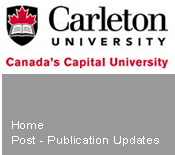



| Admissions | Regulations | Programs | Courses | Officers | The University |
| The Academic Year |
| Electronic Access to the Undergraduate Calendar |
| Accreditation of the University |
| Disclosure |
| Copyright Compliance |
| Fees |
| Selected Senate Policies |
| Map |
 |
 |
 |
 |
|
|
B. Academic Regulations for Degree Students4.0 General Regulations and Definitions4.1 The Comprehensive Regulations4.1.1 The Senate of Carleton University may at any time require a student to withdraw from the University if his or her conduct, attendance, work or progress is deemed unsatisfactory. 4.1.2 Acceptance by the University of a registration does not exempt the student from any academic regulation. 4.2 Regulations Governing a Studentís ProgramCurriculum and regulations are subject to change as the University updates and improves its undergraduate program. These changes may include alterations to course offerings, program requirements and academic regulations. In establishing transition policies that determine how these changes will impact in-program students, the University is guided by the intent that students retain the same or improved overall opportunities to succeed. The following policies are in effect: 4.2.1 A degree student who has been admitted to a program continues, in subsequent years, to be governed by the regulations in the Undergraduate Calendar of the year of admission. An exception is made for the requirements for a Minor, which may be taken from a subsequent Calendar. 4.2.2 If, in subsequent years, the student is readmitted to or reinstated in the same program or another program for any reason, the student will be governed by the regulations of the Undergraduate Calendar of the year of readmission or reinstatement. An exception is made for the requirements for a Minor, which may be taken from a subsequent Calendar. 4.2.3 As changes are made, students may choose to complete their studies under new regulations that are introduced in subsequent years, provided they meet the requirements of these regulations. In such cases, students will be governed by both the regulations and program requirements of a single Undergraduate Calendar, dated the year of, or subsequent to, admission or readmission. An exception is made for the requirements for a Minor, which may be taken from a different, single Calendar. 4.2.4 Notwithstanding 4.2.1, when circumstances prevent regulations,program requirements or courses of a previous Calendar from continued application, appropriate replacement policies guiding students in adapting to the new situation will be developed and communicated to students. 4.3 Absence from the UniversityDegree students who have been away from the university for more than fifteen consecutive terms must apply for readmission through Admission Services. 4.4 Student CategoriesThe undergraduate students of the University are grouped in four broad categories: Degree Students, Certificate Students, Special Students, and Non-credit Students. Within the Degree Students category, a further subdivision is defined as Degree Students Admitted with Additional Requirements. This subdivision includes:
If a student Admitted with Additional Requirements fails to meet these conditions, they may not continue at the University for a period of one year and must then apply for re-admission if they wish to return. The category of Certificate Students includes all students registered in the certificate and diploma programs identified in 11.0 Certificates and Diplomas. Those registered in other non- credit professional or development certificates offered by the university are not included. A student may be simultaneously both a Degree Student and a Certificate Student. 4.5 Types of ProgramsThe undergraduate programs of the university are divided into three categories. Honours programs General programs Engineering and Design programs 4.6 Program StructureProgram Elements In most programs certain course credits are identified as constituting the Major. The Major specifies the required course credits in one or more defined disciplines, themes, or fields that are the principal focus of a studentís program. The Academic Performance Evaluation described below makes use of this distinction by calculating a Major average as well as an Overall average. A Combined Honours program may be structured with two Majors, one in each contributing discipline or, in some cases, as a single Major. A multidisciplinary program is structured as a single Major drawing together courses from several disciplines. Some programs specify a limited set of credits that constitute a Core. These are courses of special importance to the program and are subject to specific CGPA requirements. A Concentration or Specialization is a defined set of courses which provides a student with specific expertise, knowledge and/or practice and so further distinguishes the program in a recognizable way. The credits in the concentration or specialization may or may not be part of the Major. Successful completion of a concentration or specialization is recorded on the diploma. A Stream is a pattern of courses within the program that guides the studentís studies and is distinctive from other patterns, but does not result in a designation on the diploma. Additions to a Program An Option is an addition to a program the pursuit of which does not affect eligibility for the degree without the Option. Registration in the Option does not change the degree requirements. An example is the Co-operative Education Option. Minors A Minor is a defined set of courses in a discipline or field that either introduces or extends knowledge of that discipline or field. A Minor may have its own admission requirements. Minors are only available to students already registered as Carleton degree students. Each Minor requires at least 4.0 and at most 5.0 credits. In some circumstances, credits in excess of those required for the main degree may be required to complete the Minor. A maximum of two credits may count toward both the Minor and the Major or Majors of a student ís program. 4.7 Year StatusEach summer, students in degree programs are given a Year Status according to the number of credits completed with passing grades and counting towards the degree. The categories are as follows: First Year: Second Year: Third Year: Fourth Year: Programs in the Faculty of Engineering and Design identify specific courses that must be completed for a particular year status in that program, which does not necessarily conform to the above formula. Refer to the Engineering and Design section of this Calendar for details. 4.8 Undeclared StudentsDegree students are considered "Undeclared" if they have been admitted to the degree but are not yet accepted into a program within that degree. The status "Undeclared" is available only in the B.A. and B.Sc. degrees. See the Undeclared section in the Programs section of this Calendar for recommended registration information. Normally, Undeclared students are required to be eligible to enter a program within their degree before reaching second year status. Undeclared students with second year status (see section 4.7 above) will not be allowed to register in courses. Undeclared students should consult the Student Academic Success Centre for guidance in planning their studies. 4.9 Changes of Degree and ProgramApplication is made through the Registrar's Office for admission, re-admission or re-instatement and permission to register in the following cases:
The following categories of students are required to reapply for admission through Admissions Services:
4.10 Types of Courses4.10.1 Course Categories The requirements for a degree or program may include specific named categories of courses.These categories are defined either in the main degree section of the calendar or within the program description. In addition most degrees prohibit credit for some particular set of courses. Such courses can not be used even as "free electives." Students should refer to the regulations and course categories for their degree for details. 4.10.2 Courses Set Aside Three categories of courses that do not contribute to the fulfilment of graduation requirements may appear on a student's record: Extra to the Degree (ETD) No Credit for Degree (NCD) Forfeit
5.0 Admission and Residency Regulations5.1 Transfer of Credit Prior to AdmissionWhen a student is considered for admission, credit may be granted for individual courses successfully completed at other recognized, degree-granting institutions, if:
Each application is evaluated on its own merits. 5.2 Transfer of Credit Subsequent to AdmissionLetter of Permission
Grades for successfully completed courses taken on Letters of Permission and Exchange (not including the University of Ottawa Exchange) will not be transferred, but the courses will be counted as attempts. A course taken on Letter of Permission and failed is counted as a discredit. A higher level of performance may be required in a course that would have contributed to any programmatic CGPA had the grade been transferred. Such a course with a passing grade below the minimum required will not count towards the degree, but will be counted as an attempt. University of Ottawa Exchange Agreement
Students should consult the Registrar's Office for application forms and information on procedures and deadlines. Students withdrawing from exchange agreement courses must notify the Registrar's Office by the appropriate deadlines, or a grade of Abs or F may be recorded. There may be financial implications. International Exchange Agreements 5.2 Minimum Number of Carleton Credits (Residency credits)To be eligible for graduation with a Carleton degree, certificate or diploma, each student must present a certain number of credits earned at Carleton University which have not been presented to fulfil any degree that has been previously awarded including a degree or degrees at Carleton University. These are referred to as residency credits. Courses taken under the University of Ottawa Exchange Agreement do not count as residency credits. All degree students must present a minimum of 5.0 residency credits at graduation. Due to accreditation requirements, the minimum number of residency credits for students in the Faculty of Engineering and Design is half of the total number of credits required in the program. To obtain an undergraduate certificate from Carleton University, students must present residency credits including a minimum of 4.0 credits taken at Carleton. In addition, the credits taken at Carleton and presented at graduation, including both credits completed after admission and those completed within the last ten years for which advanced standing has been granted, must include:
|
||||||||||||||||||||
|
©Carleton University 1125
Colonel By Drive, Ottawa, Ontario K1S 5B6 Canada |
||